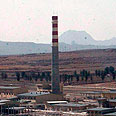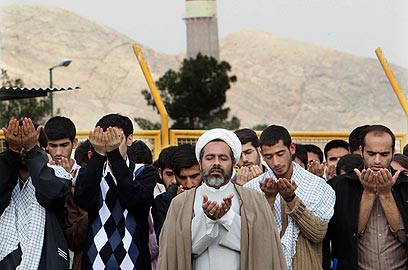
Report: Blast at Isfahan damaged nuclear facility
Based on satellite images of Iranian city, British paper The Times says Monday's explosion damaged uranium conversion site. Israeli officials say blast was 'no accident'
The Times reported on Wednesday that the mysterious explosion that rocked the city of Isfahan two days ago struck the uranium conversion facility located just outside Iran's third-largest city. According to the British newspaper, satellite images clearly show billowing smoke and destruction, despite Iran's claim that no such blast had taken place.
The Times quoted Israeli intelligence officials as saying there was "no doubt" that the blast struck the nuclear facilities at Isfahan and that it was "no accident."
Related articles:
- Britain pulls some embassy staff out of Iran
- Op-ed: IDF ready to strike Iran
- Op-ed: Iran is a different story
The uranium conversion plant is an integral part of Iran's nuclear program, where urania, also known as Yellowcake, is processed into uranium hexafluoride gas (UF6).
From there, the gas is transferred to Iran's nuclear facilities in Natanz and Qom.
Iran's official news agency Fars reported Monday night that a loud blast was heard in the city of Isfahan at 2:40 pm local time, but later removed the report.

Iranians pray near uranium conversion facility outside Isfahan (Photo: AFP)
According to the initial report, search and rescue teams called to the scene confirmed the blast, but reported no injuries.
Hours later, conflicting reports began to surface, with the deputy governor of Isfahan province telling Iran's Mehr news agency that there was no report of a major explosion in the province.
"So far no report of a major explosion has been heard from any government body in Isfahan," he was quoted as saying.
However, the news agency also quoted another Iranian media outlet as saying that a blast took place at a petrol station in a town near Isfahan.
It should be noted that according to the original report, the explosion was felt in the center of Isfahan, while the nuclear facility is located some 12 kilometers (about 7.5 miles) outside the city.
Two weeks ago, 17 Iranian servicemen were killed and several others seriously wounded in an explosion at a military base that stored missiles near Tehran. The explosion also killed Hassan Tehrani Moqaddam, one of the key figures in Iran's missile program.
Earlier this week the Institute for Science and International Security (ISIS), a Washington-based research group, published satellite images showing that most of the structures at the closed military base suffered extensive damage. Some of them appear to have been destroyed completely.
"Some of the destruction seen in the image may have also resulted from subsequent controlled demolition of buildings and removal of debris. There do not appear to be many pieces of heavy equipment such as cranes or dump trucks on the site, and a considerable amount of debris is still present. About the same number of trucks are visible in the image after the blast as in an image from approximately two months prior to the blast. Thus, most of the damage seen in the November 22, 2011 image likely resulted from the explosion," the ISIS said.
Paul Brannan, a senior research analyst for ISIS, said the satellite images could not determine whether the blast was the result of sabotage, adding that the explosion occurred as Iran achieved a "major milestone" in the development of a new missile. Iran was apparently performing a "volatile procedure" involving a missile engine at the site when the blast occurred, Brannan said.
- Follow Ynetnews on Facebook and Twitter
- Receive Ynetnews updates directly to your desktop










